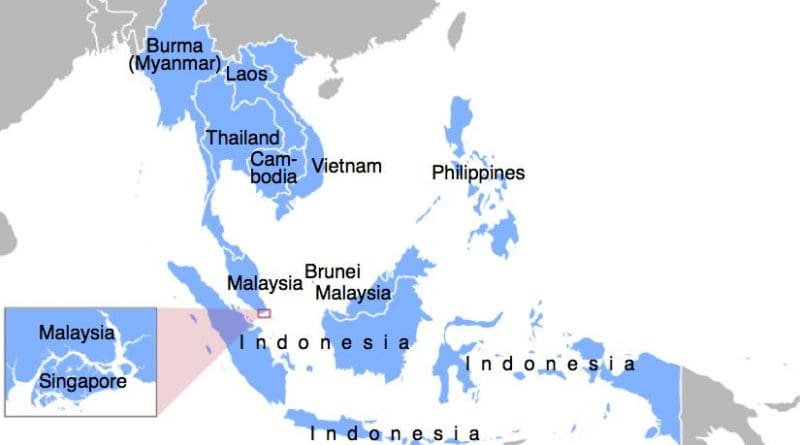Making ASEAN’s Case In The Indo-Pacific – Analysis
Almost two years after President Donald Trump outlined the United States’ vision for a Free and Open Indo-Pacific in the APEC CEO Summit in Danang, and three weeks after the U.S. Defense Department released its Indo-Pacific Strategy Report, ASEAN finally came up with its first official response to the U.S. initiative.
The “ASEAN Outlook on the Indo-Pacific” was one of the key documents that came out of the 34th ASEAN Summit held in Bangkok last week. For ASEAN to formalize its reply suggests the importance it attaches to the construct. This is not only because major powers U.S. and Japan articulate and promote it, although their visions may harbor variances, but because Southeast Asia is at the very heart of its geography. The considerable time lag before the reply suggests careful and thoughtful deliberation, observing how the concept has moved from a policy pronouncement to a coherent and resource-backed strategy. Meanwhile, the tight length – five pages – of the document provides for broad guidance and flexibility outlining the bases, areas and mechanisms for cooperation.
The Outlook has four salient points: 1) ASEAN’s appreciation of its place in the Indo-Pacific; 2) re-assertion of its interest to play an active role in shaping regional security and economic architectures; 3) reaffirmation of its desire to engage all powers, not to take sides and even act as broker for competing interests and; 4) reiteration of its aspiration for comprehensive and balanced ties with major powers outlining both its security and economic agenda.
ASEAN understands that it is situated in one of the world’s most dynamic regions and that its own fast-paced economic growth contributed to it. The ten-member bloc is also aware of the emerging great power competition, particularly between the U.S. and China, and their competing mega-regional visions. ASEAN realizes that geopolitical and geostrategic shifts taking place in the region ushers in both rewards and risks. But while being opportunistic, it knows the stakes are high should unbridled rivalry play out.
ASEAN’s view towards the Indo-Pacific shows some resemblance to its attitude towards China’s Belt and Road, but with marked differences. Announced in 2013 in Jakarta (the 21st century Maritime Silk Road and the Asian Infrastructure Investment Bank) it took four years for ASEAN and China to issue a joint statement expressing their mutual interest to deepen cooperation on infrastructure connectivity, an acceptance of Belt and Road’s potential contribution. This was followed in 2018 by a strategic partnership vision 2030. The synergy of China’s Belt and Road and ASEAN’s Master Plan for Connectivity was cited in both documents. Last April, leaders of the ten countries attended the second Belt and Road Forum in Beijing, cementing support for China’s initiative. In both cases, there is a similar time lag between the initiative’s announcement and ASEAN’s expression of support.
However, the assessment of complementarity and emphasis on the connectivity aspect of the Belt and Road is more apparent. This, of course, does not necessarily preclude ASEAN’s concerns over the Chinese-led initiative. In contrast, the lack of a central focus of the still evolving U.S. Indo-Pacific strategy encourages ASEAN to identify priority fields where it would welcome engagement with Washington. The upside of this is that the U.S. can have multiple dimensions for cooperation with ASEAN that go beyond China’s stress on connectivity.
Instead of being a mere spectator or bystander in the unfolding geopolitical and geostrategic shifts, ASEAN stresses its interest in leading “the shaping of their economic and security architecture and ensure that such dynamics will continue to bring about peace, security, stability and prosperity” in Southeast Asia and the wider Indo-Pacific. ASEAN knows that it has agency and is determined to use that. It “envisages ASEAN Centrality as the underlying principle for promoting cooperation in the Indo-Pacific region, with ASEAN-led mechanisms, such as the East Asia Summit (EAS), as platforms for dialogue and implementation of the Indo–Pacific cooperation.”
Although far from being easy, ASEAN would like to influence great power rivalry, channel its energies to healthy and productive endeavors (such as connectivity and trade facilitation) and mitigate risks attendant to the same. The Outlook made references to this. For instance, it states that the “rise of material powers, i.e. economic and military, requires avoiding the deepening of mistrust, miscalculation, and patterns of behavior based on a zero-sum game.” ASEAN also hoped for an “Indo-Pacific region of dialogue and cooperation instead of rivalry.”
ASEAN also aspired to “continue being an honest broker within the strategic environment of competing interests.” Singapore and Hanoi, for instance, hosted two summits respectively that brought President Trump and North Korean leader Kim Jong-Un to the negotiating table. Singapore, in the last Shangri-la Dialogue, provided a platform for both U.S. Acting Defense Secretary Patrick Shanahan and China’s Defense Minister and State Councilor Wei Fenghe to articulate their countries’ respective security visions. Despite recognizing possible backlash from Beijing, ASEAN’s willingness to engage Washington in the maritime domain signals its resolve to balance against China’s growing military presence in the South China Sea.
The numerous areas of cooperation listed in the Outlook document highlights the multiple points of entry for U.S. engagement – security, economic, social, scientific, etc. It also carries the subtext that ASEAN wants an engagement that goes beyond security. In fact, it can be said that ASEAN’s reluctance to take part in the Indo-Pacific strategy is a function of its concern over its overly security dimension. America’s branding of China as a revisionist power further sharpens the strategy’s disposition against ASEAN’s largest trade partner, key investor and emerging infrastructure funder, putting member countries in a tight spot. Thus, while developing the strategy’s economic and other pillars will go a long way in soothing ASEAN qualms, navigating amidst great power rivalry will continue to pose serious problems for regional governments.
This article was published by China-US Focus

